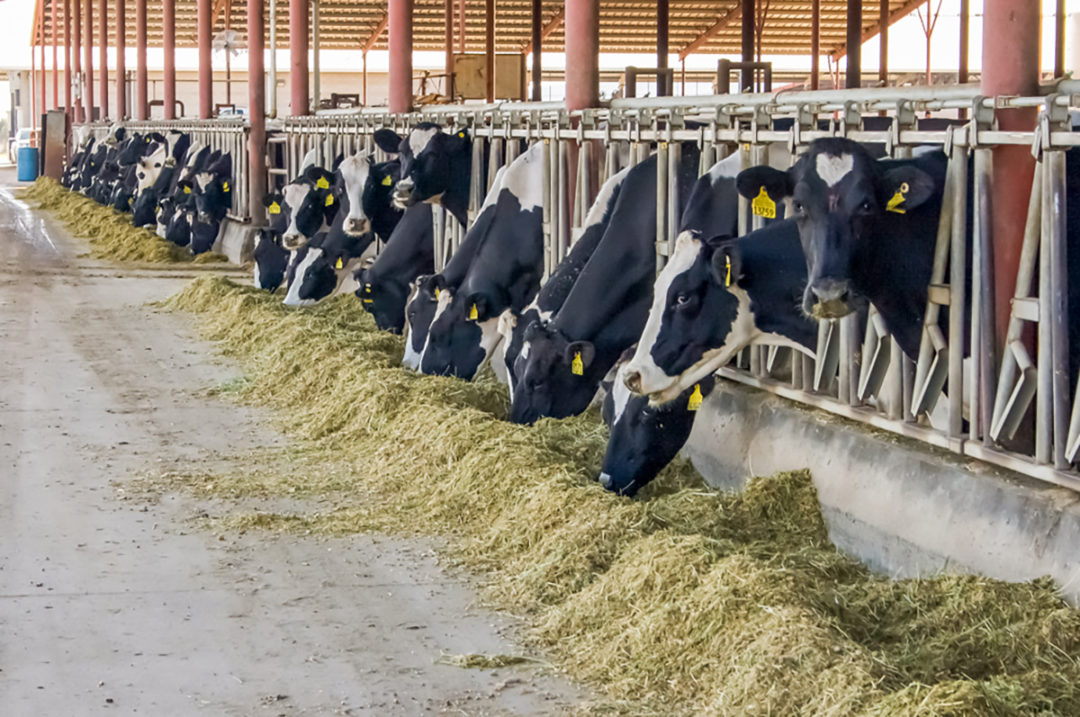A proper rumen pH is critical to dairy cows being healthy and productive. A careful balance must be attained in the diets, so high milk production can be achieved without pushing the energy and starch levels too high, while also keeping adequate fiber levels to keep the rumen functioning well. Fiber is a stimulus for cud chewing, which also stimulates saliva production. Saliva acts as a buffer for rumen pH because it contains high levels of sodium, potassium, bicarbonates and phosphorus. Most dairy rations include the addition of buffers to ensure that pH is maintained.
Higher-starch rations increase acid production, sometimes causing acidosis, which is characterized by low rumen pH. Rumen acidosis is the number one metabolic disorder diagnosed by the University of Wisconsin Veterinary College, with sub-acute acidosis (SARA) being the most common form seen today. Rumen pH below 6.2 inhibits rate of digestion, favors growth of lactic acid-producing bacteria and inhibits growth of cellulolytic, hemicellulolytic and pectinolytic bacteria. These “good” bacteria play a major role in digestion and require ruminal pH to be maintained at 6.7 plus or minus 0.5 to thrive. A conservative estimate of the cost to the U.S. dairy herd is $1.12 per cow, per day and affects 40% of the herd. The lost revenue is due to increased lameness, increased culling rates, higher vet costs and decreased milk production and components.
There are many nutrition and management factors that can impact rumen pH, both positively and negatively.
Let’s start with the ration
-
Formulate rations for the stage of lactation and size of the animal. Fresh cows are more prone to SARA because their energy expenditure exceeds the energy consumed. Sometimes, rations may push the boundaries on fiber (too low) and starch (too high) as nutritionists strive to supply these cows with enough calories to meet their energy requirements. Separate rations for fresh and early lactation cows can be formulated with lower-starch ingredients, such as soyhulls and corn gluten feed.
-
Ensure enough physically effective fiber in the rations. Tools like the Penn State Particle Separator can help determine if enough effective fiber is in the ration. Taking multiple samples along a lactation group’s feedbunk and shaking the samples out can determine if the total mixed ration (TMR) is properly mixed, with low coefficient of variation between the samples. A more common use is to evaluate if a ration has adequate fiber levels. At least 2% to 8% of particles should remain on the top screen, with these particles being no larger than approximately 2 1/2 inches wide to avoid sorting. More than 50% on the bottom screen may indicate inadequate particle size, causing a high rate of passage. The bottom screen can also contain a high proportion of concentrate or rapidly fermentable carbohydrate, possibly contributing to or causing SARA.
-
Sample forages regularly. Sample individual forages frequently to closely monitor dry matter, fiber and energy variations. Even small changes may be enough to cause digestive upset if not addressed.
- Additives can be helpful to keep the rumen healthy. Buffers such as sodium sesquicarbonate and sodium bicarbonate are added to the ration to help maintain rumen pH. As mentioned before, cows will also produce bicarbonate in their saliva. Adding supplemental buffer can also increase the dietary cation-anion difference (DCAD). A higher DCAD optimizes milk and milk component production, as well as efficiency.
Managing feeding behavior
Management factors, such as social dominance (submissive versus dominant) behaviors as well as feeding patterns, can impact rumen pH of cows. Being proactive can help minimize negative behaviors.
-
Feed multiple small meals a day. Large meals consumed quickly can cause major pH swings in the rumen. Feeding more than once a day encourages cows to eat smaller meals more often. Such practice can aid in stabilizing rumen pH levels, which results in improved milkfat content and efficiency of production.
-
Push up and redistribute feed multiple times during the day and night. Sounds simple, but cows cannot eat feed that is not within reach. They are also more likely to slug feed when feed does become available if they have been without feed too long.
-
Grouping strategy is important. Small cows, such as 2-year-olds, can be timid around larger, older cows, which can impact a small cow’s eating patterns. Formulating separate rations for these smaller cows and putting them in separate groups can help these cows eat more consistent meal sizes. If creating separate groups is not possible, ensure the pen is not overstocked to allow smaller cows a better chance to eat.
-
Keep barns cool. Fans and misters can lower temperatures in barns and holding areas. Cows relieve heat stress by sweating and panting. When heat stress is severe, panting progresses to open-mouth breathing. This leads to respiratory alkalosis because of the increased loss of carbon dioxide and increased urinary output of bicarbonate to compensate. The salivary bicarbonate pool for rumen buffering is also decreased by cows drooling. Because cows lose bodily stores of bicarbonate, rumen pH can drop during heat stress. Cows tend to eat less, and meal sizes vary during extreme heat.
-
Avoid overstocking pens. Feeding times are shortened when cows are overstocked due to increased competition. The result is cows eat fewer, larger meals, with long periods of standing and waiting between meals. Research has shown that increasing stocking from 100% to 142% can cause rumen pH to drop, leading to less milk production and lower butterfat. One study found that overstocked cows also ate 25% faster and ruminated one hour less.
- Minimize time in headlocks and encourage lying time. Time spent in the headlocks is time that could have been spent lying down. Research at Miner Institute demonstrated cows that achieved 80% to 90% of their rumination in stalls had far less SARA than cows who achieved 50% to 60% of their rumination in stalls. A good rule of thumb is to observe at least 50% or more of the cows lying down chewing their cuds.
Focusing on the dietary and management factors above can have beneficial effects on rumen pH, resulting in healthier, more productive cows.
Author's note: Any information or guidance contained in this communication is provided as a courtesy and should not be used to supplement feed, performance or other advice specific to any particular person, group or circumstance. Genesis Alkali does not guarantee that the above recommendations will ensure a stable pH, increase production or any other outcome and makes no warranties whatsoever with respect to the statements made herein. The reader is responsible for determining whether the above recommendations are suitable for use and implementation.










